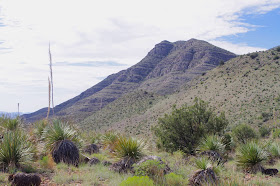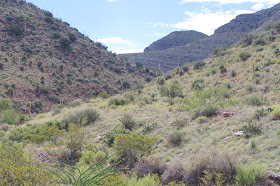I got the correct distance to the road I had been looking for the previous day from Google Earth, and the next morning I was once again driving in the thick sand of Faulkner Canyon. As I had guessed the turn-off was in a side channel concealed by a thick growth of desert willow. The first 100 feet of this road are not good and had me thinking twice about about this whole little adventure. Luckily things improved, not a lot, but enough to let me continue. The going is pretty rough up a couple of hills to get onto the mesa. Years ago, I was able to make in a two wheel drive Izusu Rodeo. I'm pretty sure that would not be the case now. Which got me to wondering: are these un-maintained roads only getting worse, or do they self-correct over time?
Up on the flat terrain of the plateau, driving conditions were much more benign. I parked near the intersection where another primitive road heads off to the south. I looked a the hill that goes down into East Faulkner Canyon, where the road continues east and then north to the top of Lookout Mountain, and thought it wasn't any worse than what I've come through already,but I've always parked on top so I stuck with tradition. Anyway, my plan for this day, was to head downstream in East Faulkner then head upstream in its tributary to the north, so driving to the bottom of the hill wouldn't have helped much.
I set off at a fast pace, clanging my two hiking poles on rocks in an effort to wake up any sleeping snakes and induce them to move off or at least giving a warning rattle. The arroyo was thick with snakeweed, mesquite, verbena and even grass: plenty of places for the proverbial snake to conceal itself. The walking in the tributary arroyo was even tougher with no clear path in the channel, and a pavement of loose football sized boulders on the banks.
 It was clear where all the rocks came from. The steep north side of the canyon was almost entirely made up of a series of rock glaciers.When I came to a side gully, cut in bedrock and seeping a little water, I decided to climb up and walk along the hills on the south side. Junipers were bushy and green, and hopefully quite happy with the recent rainy conditions,as the flycatchers,sparrows and quail seemed to be. From above, I could see the canyon transition into bedrock with nice little pools of water, so I headed down to the bottom. Once there I could the stream was actually trickling along for several hundred yards. Running water is always a magical moment in the desert.
It was clear where all the rocks came from. The steep north side of the canyon was almost entirely made up of a series of rock glaciers.When I came to a side gully, cut in bedrock and seeping a little water, I decided to climb up and walk along the hills on the south side. Junipers were bushy and green, and hopefully quite happy with the recent rainy conditions,as the flycatchers,sparrows and quail seemed to be. From above, I could see the canyon transition into bedrock with nice little pools of water, so I headed down to the bottom. Once there I could the stream was actually trickling along for several hundred yards. Running water is always a magical moment in the desert.

I rested a bit. The road crossing was just ahead of me and I could see the top of Lookout Mountains, which seemed tantalizingly close. I cut out cross country to the southeast and picked the road up at the low saddle between the two highest mountain masses of the range. Views across the river to the Doña Ana Mountains were spectacular, as were those closer in, up to Robledo Peak. This is really a beautiful spot and worth the price of admission, even one doesn't decide to climb the peaks.
I now walked along the road, which taking me south and then east would be the return leg of my loop hike.

 As I walked I was puzzled by mounds of dirt, obviously human work, along the road side. If someone out there knows what they are, clue me in.
As I walked I was puzzled by mounds of dirt, obviously human work, along the road side. If someone out there knows what they are, clue me in.Where the road descends back down to the canyon, it is nothing but rocks, and must make for an extremely uncomfortable ride. I don't think I would do it,but I believe there are people who occasionally make the trip in a suitable vehicle all the way to the top of the mountain.
In the wash of East Faulkner Canyon, there are several oddities to observe. First, even though the canyon sides are blocky, red,black and brown volcanic rocks, the gravel in the streambed is almost entirely gray limestone. Second, there are occasional xenoliths of this same Permian limestone to be seen encased in the Tertiary volcanics. I did some cursory looking about for any artifacts or rock art, as I have in the past,but found none. It seems like this canyon is absolutely ripe for finding evidence of ancient use,but so far has been disappointing, as has the main Faulkner Canyon.

Back at the vehicle, I walked down the road to the south for a bit. A few more observations came to mind. The steep west face of the highest parts of the Robledos seems to have been created by a relatively recent ( in geologic time) long fault that runs along the base and has only two canyons of any size that have penetrated it. The canyon I was walking in ( the one I'm calling East Faulkner) and Indian Springs Canyon further to the south. East Faulkner divides the sedimentary and igneous parts of the range, while Indian Springs is at the transition point between the higher ridges and peaks, and the long swath of low hills that runs all the way down to Picacho Peak.

Driving back down, I spied an alternate route to reconnect to Faulkner Canyon, but there was no guarantee it was any better( and may have been worse) so I stuck with what I knew. It had been a beautiful morning in the mountains, why take a chance of screwing up it up on the ride back to the pavement.







No comments:
Post a Comment